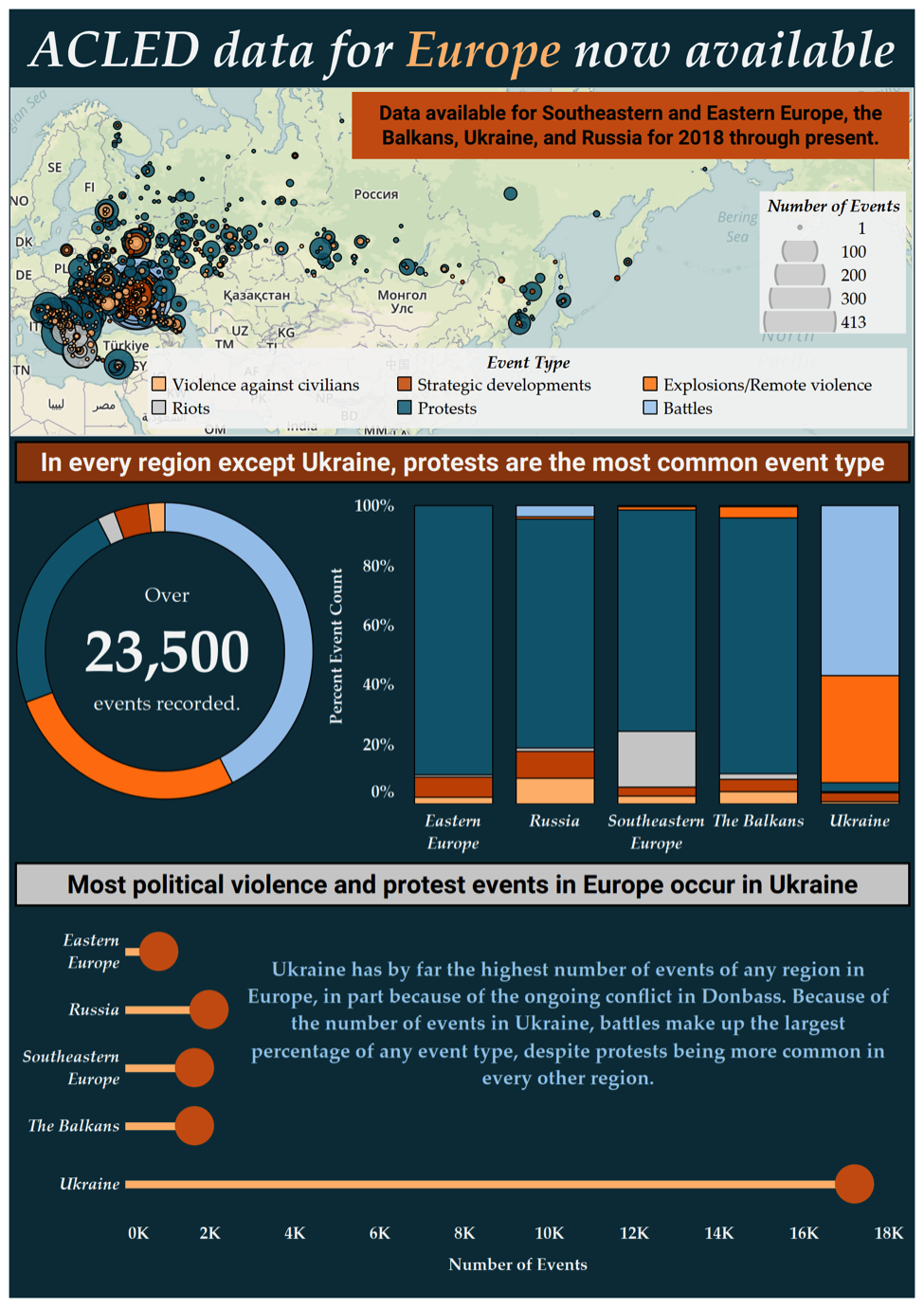2 April 2019: Data for more than 23,500 political violence and protest events across Eastern Europe are now available from the Armed Conflict Location & Event Data Project (ACLED). Spanning 15 countries, the dataset encompasses Eastern and Southeastern Europe, the Balkans, Ukraine, and Russia. Coverage extends from January 2018 to the present, with weekly real-time data releases.
Conflict in Eastern Europe is concentrated in Ukraine’s Donbass region, where ACLED has recorded over 1,000 battles or incidents of explosions/remote violence1ACLED classifies “Explosions/Remote violence” events as one-sided violent events including bombs, grenades, improvised explosive devices (IEDs), artillery fire or shelling, missile attacks, heavy machine gun fire, air or drone strikes, chemical weapons, and suicide bombings. If such events are reported in the context of an ongoing battle, they are instead coded as part of a “Battle” event. Find more information in ACLED’s Codebook. every month since the beginning of last year, causing more than 1,000 total reported fatalities. Though the March 2018 ceasefire agreement was followed by a 50% drop in violence, the respite was temporary: conflict spiked again in the spring, and May was the most lethal month of the entire year according to ACLED data. Ahead of the March 2019 election, protest activity rose slightly after a general decline in 2018, with a particular uptick in violent demonstrations led by right-wing nationalist groups.
Across Russia and the remainder of the region, demonstrations against the government, as well as those calling for reforms to address poor socio-economic conditions and national identity issues, dominate the disorder landscape.
Commenting, ACLED Executive Director Clionadh Raleigh said: “ACLED’s expansion makes it the most rigorous source of real-time data on political violence and protest in Eastern Europe, allowing journalists, researchers, and practitioners to investigate conflict patterns across the region — almost as they happen. From war in eastern Ukraine to unrest in Russia, the Eastern Europe dataset is a crucial new tool for mapping emerging crises.”
The State of Political Violence and Protest in Eastern Europe:
- Since the start of 2018, ACLED has recorded over 23,500 political violence and protest events in the region
- More than 16,500 are organized political violence events2Such as battles, explosions/remote violence events like airstrikes, and violence against civilians. (16,300 of which take place in Ukraine); over 5,500 are peaceful protests; and over 450 are violent riots
- Political violence is linked to over 1,200 reported fatalities3Fatality numbers are frequently the most biased and poorly reported component of conflict data. While ACLED codes the most conservative reports of fatality counts to minimize over-counting, this does not account for biases that exist around fatality counts at-large. Find more information about ACLED’s methodology for coding fatalities here. since the start of 2018
- More than 1,000 are reported in Ukraine and nearly 150 in Russia
- Battles account for approximately 58%, and explosions/remote violence account for 9%
- More than 430 violent events targeting civilians have resulted in dozens of reported fatalities stemming from direct attacks; this does not include civilians killed as a result of collateral damage
- Overall violence and reported fatalities have dropped since early 2018, except in Ukraine
- The number of demonstration events has increased, with protests in Serbia, Russia, and Greece rising sharply since January 2019
Ongoing Conflict in Ukraine:
- Ukraine is by far the most violent country covered in the dataset, with over 16,300 organized political violence events and over 600 demonstration events
- Battles are common, making up more than 55% of all political violence or demonstration events
- Over 1,000 fatalities are reported in Ukraine since January 2018
- Ceasefire agreements have had limited effect on the Donbass conflict
- In the three weeks following the 5 March 2018 truce, battles and explosions/remote violence events dropped by 50%, only to return to previous levels in April 2018. The most lethal fighting of the entire year occurred in May 2018
- The number of battles and explosions/remote violence events doubled from early 2018 to October 2018, but has since declined
- ACLED recorded a 50% drop in demonstration events over the course of 2018, though activity increased in the run-up to the March 2019 presidential elections
- Demonstration and political violence events involving right-wing nationalist groups such as the National Corps, Svoboda, and Right Sector have generally declined since early 2018, but levels rose again in February and March 2019. The National Corps and its paramilitary wing, the National Militia, have led several violent demonstrations against incumbent President Petro Poroshenko
Dissent and Repression in Russia:
- ACLED records over 2,000 political violence and protest events in Russia since January 2018
- Demonstrations, including anti-government protests, account for the vast majority of events
- The government intervened in nearly 300 protest events, or 17% of approximately 1,800 events
- Protests surged and were suppressed at multiple periods throughout 2018. Protest activity rose again in early 2019 but has so far faced less government interference than last year
- Political violence in the North Caucasus accounts for nearly 70% of all fatalities reported in Russia
- Regular clashes between government forces and armed groups like the Islamic State have resulted in over 90 reported fatalities since the start of 2018
Download a PDF of this press release here.
A US-based 501c3 established in 2014, ACLED is the highest quality, most widely used, real-time data and analysis source on political violence and protest around the world.
If you would like to use ACLED analysis or visuals, please review our Terms of Use and Attribution Policy.
For interview requests and press inquiries, please contact:
Sam Jones, Communications Manager





